coolant level SAAB 9-3 2006 Owners Manual
[x] Cancel search | Manufacturer: SAAB, Model Year: 2006, Model line: 9-3, Model: SAAB 9-3 2006Pages: 318, PDF Size: 28.05 MB
Page 6 of 318
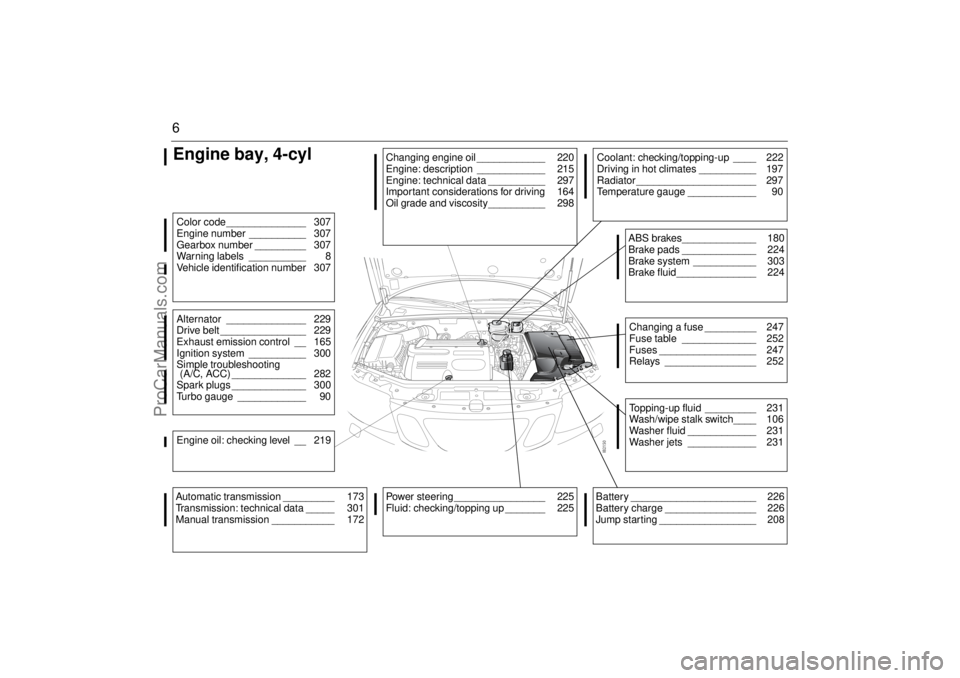
6Engine bay, 4-cylColor code______________ 307
Engine number __________ 307
Gearbox number _________ 307
Warning labels __________ 8
Vehicle identification number 307Alternator ______________ 229
Drive belt _______________ 229
Exhaust emission control __ 165
Ignition system __________ 300
Simple troubleshooting
(A/C, ACC) _____________ 282
Spark plugs _____________ 300
Turbo gauge ____________ 90Engine oil: checking level __ 219Automatic transmission _________ 173
Transmission: technical data _____ 301
Manual transmission ___________ 172
Battery ______________________ 226
Battery charge ________________ 226
Jump starting _________________ 208
Changing engine oil ____________ 220
Engine: description ____________ 215
Engine: technical data __________ 297
Important considerations for driving 164
Oil grade and viscosity__________ 298
Topping-up fluid _________ 231
Wash/wipe stalk switch____ 106
Washer fluid ____________ 231
Washer jets ____________ 231
Power steering ________________ 225
Fluid: checking/topping up _______ 225
Coolant: checking/topping-up ____ 222
Driving in hot climates __________ 197
Radiator _____________________ 297
Temperature gauge ____________ 90
Changing a fuse _________ 247
Fuse table _____________ 252
Fuses _________________ 247
Relays ________________ 252ABS brakes_____________ 180
Brake pads _____________ 224
Brake system ___________ 303
Brake fluid______________ 224
93U S M 06.book Page 6 Friday, February 18, 2005 1:15 PM
ProCarManuals.com
Page 7 of 318
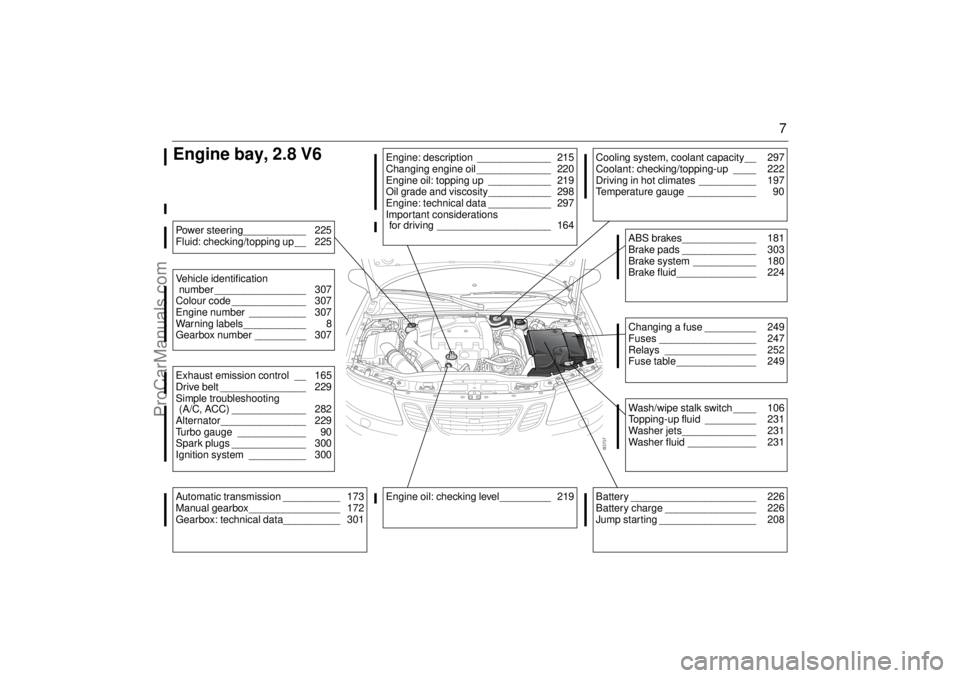
7
Engine bay, 2.8 V6Power steering___________ 225
Fluid: checking/topping up__ 225Vehicle identification
number ________________ 307
Colour code _____________ 307
Engine number __________ 307
Warning labels___________ 8
Gearbox number _________ 307Exhaust emission control __ 165
Drive belt _______________ 229
Simple troubleshooting
(A/C, ACC) _____________ 282
Alternator_______________ 229
Turbo gauge ____________ 90
Spark plugs _____________ 300
Ignition system __________ 300Automatic transmission __________ 173
Manual gearbox________________ 172
Gearbox: technical data__________ 301
Engine: description _____________ 215
Changing engine oil _____________ 220
Engine oil: topping up ___________ 219
Oil grade and viscosity___________ 298
Engine: technical data ___________ 297
Important considerations
for driving ____________________ 164Engine oil: checking level_________ 219
Battery ______________________ 226
Battery charge ________________ 226
Jump starting _________________ 208
Wash/wipe stalk switch ____ 106
Topping-up fluid _________ 231
Washer jets_____________ 231
Washer fluid ____________ 231Changing a fuse _________ 249
Fuses _________________ 247
Relays ________________ 252
Fuse table ______________ 249ABS brakes_____________ 181
Brake pads _____________ 303
Brake system ___________ 180
Brake fluid______________ 224
Cooling system, coolant capacity__ 297
Coolant: checking/topping-up ____ 222
Driving in hot climates __________ 197
Temperature gauge ____________ 90
93U S M 06.book Page 7 Friday, February 18, 2005 1:15 PM
ProCarManuals.com
Page 8 of 318
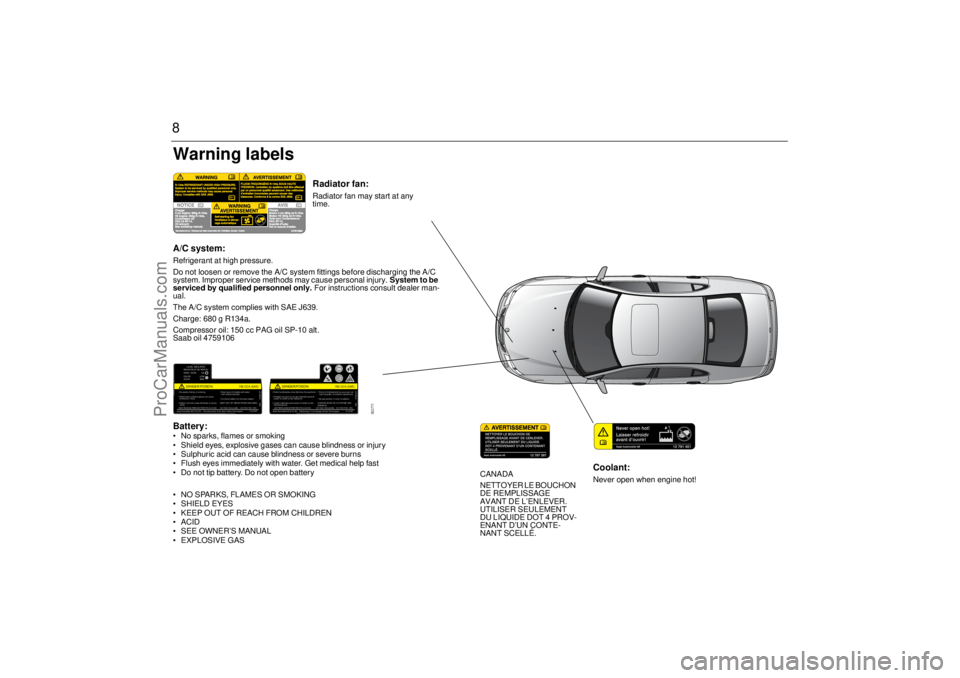
8
Coolant:Never open when engine hot!
Radiator fan:Radiator fan may start at any
time.
Battery: No sparks, flames or smoking
Shield eyes, explosive gases can cause blindness or injury
Sulphuric acid can cause blindness or severe burns
Flush eyes immediately with water. Get medical help fast
Do not tip battery. Do not open battery
NO SPARKS, FLAMES OR SMOKING
SHIELD EYES
KEEP OUT OF REACH FROM CHILDREN
ACID
SEE OWNER’S MANUAL
EXPLOSIVE GASWarning labelsA/C system:Refrigerant at high pressure.
Do not loosen or remove the A/C system fittings before discharging the A/C
system. Improper service methods may cause personal injury.
System to be
serviced by qualified personnel only. For instructions consult dealer man-
ual.
The A/C system complies with SAE J639.
Charge: 680 g R134a.
Compressor oil: 150 cc PAG oil SP-10 alt.
Saab oil 4759106
DANGER/POISON
700 CCA (SAE)
LEVEL INDICATOR
INDICATEUR DE NIVEAU
DARK / NOIR No sparks, flames or smoking. Flush eyes immediatly with water
Do not tip battery. Do not open battery
KEEP OUT OF REACH FROM CHILDREN.
000 12102-EP
Shield eyes, explosive gases can cause
blindness or injury.Get medical help fast.
Sulfuric acid can cause blindness or severeMAINTENANCE-FREE BATTERY-P/N 53 52 000 12V/700A/125min(SAE) 12V/700A/70Ah (EN)
Saab Automobile AB 53 53 057 Manufactured by Tudor Spain (Exide Technologies) 12102-EPburns.
OK
CLEAR
CLAIRLOW
BAS
DANGER/POISON
700 CCA (SAE)
Éviter les étincelles et les flammes. Ne pas fumer. Rincer immédiatement les yeux avec de
Ne pas pencher ni ouvrir la batterie.
GARDER HORS DE LA PORTÉE DES
ENFANTS
000 12103-EP
Protéger les yeux car les gaz explosife peuvent
causer la cécité ou des blessures.l'oau Consulter un médecin rapidement.
L'acide sulfurique peut causer la cécité ou desBATTERIE SANS ENTRETIEN-P/N 53 52 000 12V/700A/125min(SAE) 12V/700A/70Ah (EN)
Saab Automobile AB 53 53 085 Fabriquée par Tudor Espagne (Exide Technologies) 12103-EPbrûlures graves.
CANADA
NETTOYER LE BOUCHON
DE REMPLISSAGE
AVANT DE L’ENLEVER.
UTILISER SEULEMENT
DU LIQUIDE DOT 4 PROV-
ENANT D’UN CONTE-
NANT SCELLÉ.
93U S M 06.book Page 8 Friday, February 18, 2005 1:15 PM
ProCarManuals.com
Page 10 of 318
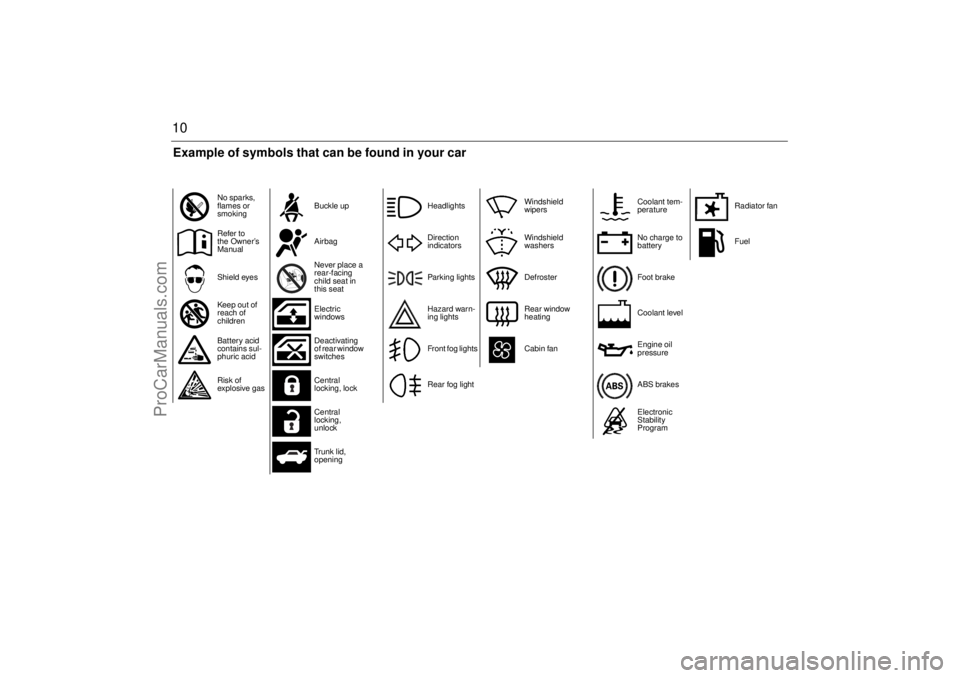
10
No sparks,
flames or
smokingBuckle up
Refer to
the Owner’s
ManualAirbag
Shield eyesNever place a
rear-facing
child seat in
this seat
Keep out of
reach of
childrenElectric
windows
Battery acid
contains sul-
phuric acidDeactivating
of rear window
switches
Risk of
explosive gasCentral
locking, lock
Central
locking,
unlock
Trunk lid,
opening
HeadlightsWindshield
wipers
Direction
indicatorsWindshield
washers
Parking lights Defroster
Hazard warn-
ing lightsRear window
heating
Front fog lights Cabin fan
Rear fog light
Coolant tem-
peratureRadiator fan
No charge to
batteryFuel
Foot brake
Coolant level
Engine oil
pressure
ABS brakes
Electronic
Stability
Program
Example of symbols that can be found in your car93U S M 06.book Page 10 Friday, February 18, 2005 1:15 PM
ProCarManuals.com
Page 90 of 318

90 Instruments and controlsTemperature gaugeThe temperature gauge shows the temper-
ature of the coolant. The needle should be
in the middle of the scale when the engine
is at normal operating temperature.
If the needle goes into the red zone (which
can occur at high outside air temperatures
or under heavy engine loads), choose the
highest possible gear ratio and the lowest
possible engine speed, and avoid shifting
down.If the needle repeatedly enters the red zone,
stop the car as soon as it is safe to do so and
check the coolant level (see page 222).
Turbo gaugeThe turbo gauge indicates the air volume
used for combustion, which is equivalent to
the engine load.
At low loads and when the engine is used for
braking, the needle will move within the
white zone.
Under certain barometric conditions the
needle may enter the first part of the red
zone without necessarily indicating that a
fault has arisen.
NOTICEIf the needle, despite the above action,
enters the red zone, stop the car in a suit-
able place and allow the engine to idle. If
the needle continues to rise, switch off the
engine.
WARNING
Never open the cap of the expansion tank
completely when the engine is hot, open
with care. The pressure in the cooling-
system can cause hot coolant and steam
to be released. Failure to heed this warn-
ing may result in personal injury.
93U S M 06.book Page 90 Friday, February 18, 2005 1:15 PM
ProCarManuals.com
Page 195 of 318

195 Starting and driving
Driving in cold weatherIn cold weather, special attention should be
paid to the following:
Before driving off, make sure that the
wiper blades have not frozen to the wind-
shield.
Remove any snow from the heating
system air intakes between the hood and
the windshield.
If necessary, inject oil into the locks to
prevent them from freezing. Use molyb-
denum-sulphide oil (MoS
2). If the locks
freeze, exercise care when unlocking the
car (manual unlocking) to avoid breaking
the key. Warm up the key or use a de-icer.
It is particularly important when the roads
are slippery that the brakes and tires are
in good condition.
For how to check the level of antifreeze in
the engine coolant, see page 222.
Add gasoline anti-freeze when refueling
several times before the onset of winter.
This will prevent condensation water in
the fuel tank from freezing and causing
interruptions in the fuel supply. The likeli-
hood of condensation is lowest when the
fuel tank is full.
If the car is parked outside and the
temperature is below zero, gasoline anti-
freeze is of little use as it cannot remove
water that has already frozen. Park the
car in a warm place so that any ice that
may have built up melts, then add gaso-
line anti-freeze when refueling.Condensation is caused by temperature
fluctuations, either in the outside temper-
ature alone or when the car is alternately
parked outdoors and in a garage.
Convertible: Avoid operating the soft top
at temperatures below 23°F (–5°C).
The car is equipped with tires designed to
provide optimum grip on both wet and dry
roads, although this has been achieved at
the expense of somewhat reduced grip on
snow and ice. For regular driving on snow
and ice, we therefore recommend that
winter tires be fitted. However, winter tires
achieve this extra grip at the expense of
grip on bare road surfaces.
Winter tires, particularly studded tires, gen-
erally make driving safer on snow and ice.
Acquaint yourself with the legal provi-
sions governing the use of different
types of winter tires and snow chains.
Studded tires are not allowed in some
countries. If winter tires are fitted, the same
type must be fitted to all four wheels. Your
Saab dealer will be pleased to advise you on
the best tires for your car.
93U S M 06.book Page 195 Friday, February 18, 2005 1:15 PM
ProCarManuals.com
Page 197 of 318
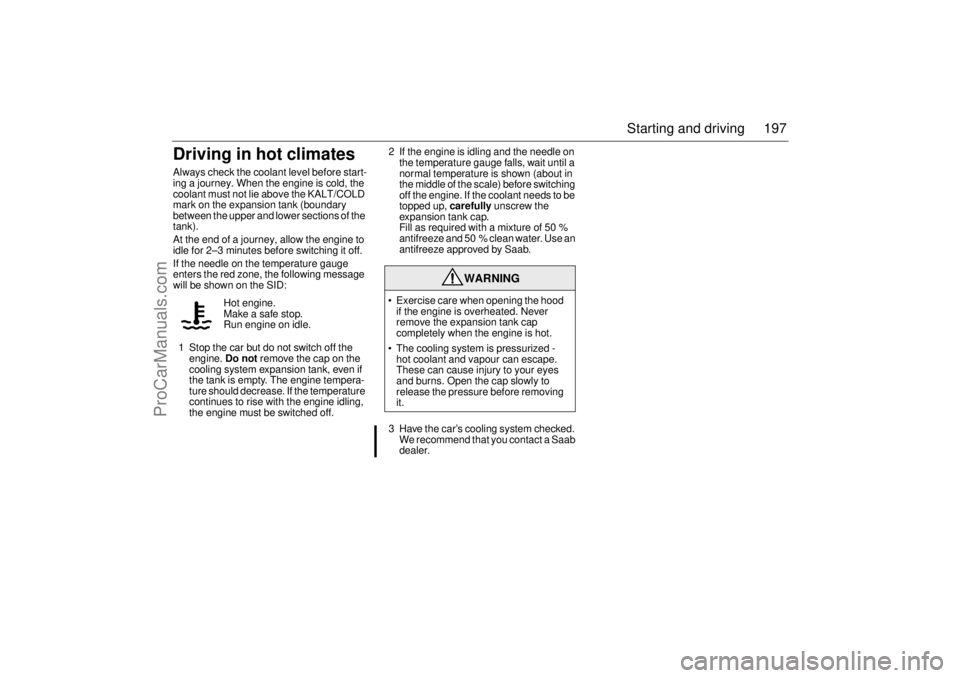
197 Starting and driving
Driving in hot climatesAlways check the coolant level before start-
ing a journey. When the engine is cold, the
coolant must not lie above the KALT/COLD
mark on the expansion tank (boundary
between the upper and lower sections of the
tank).
At the end of a journey, allow the engine to
idle for 2–3 minutes before switching it off.
If the needle on the temperature gauge
enters the red zone, the following message
will be shown on the SID:
1 Stop the car but do not switch off the
engine. Do not remove the cap on the
cooling system expansion tank, even if
the tank is empty. The engine tempera-
ture should decrease. If the temperature
continues to rise with the engine idling,
the engine must be switched off.2 If the engine is idling and the needle on
the temperature gauge falls, wait until a
normal temperature is shown (about in
the middle of the scale) before switching
off the engine. If the coolant needs to be
topped up, carefully unscrew the
expansion tank cap.
Fill as required with a mixture of 50 %
antifreeze and 50 % clean water. Use an
antifreeze approved by Saab.
3 Have the car’s cooling system checked.
We recommend that you contact a Saab
dealer. Hot engine.
Make a safe stop.
Run engine on idle.
WARNING
Exercise care when opening the hood
if the engine is overheated. Never
remove the expansion tank cap
completely when the engine is hot.
The cooling system is pressurized -
hot coolant and vapour can escape.
These can cause injury to your eyes
and burns. Open the cap slowly to
release the pressure before removing
it.
93U S M 06.book Page 197 Friday, February 18, 2005 1:15 PM
ProCarManuals.com
Page 211 of 318

211 Starting and driving
For long tripsBefore starting off on a long journey, it is
advisable to have your car inspected by
your Saab dealer.
Obtain a few important items to take along
on your journey, such as spare bulbs, wiper
blades, fuses, a drive belt (poly-V-belt) and
the like.
You can check some points yourself before-
hand:
Check that no oil or fuel leaks out of the
engine or gearbox/transmission.
Check the coolant and power steering
fluid levels. Check also for leaks.
Inspect the drive belt (poly-V-belt) and
replace if it shows any signs of wear.
Check the battery charge.
Check the tires for tread pattern and air
pressure, including the compact spare
tire.
Take an extra remote control and keep it
separate.
Check the brakes.
Check all bulbs.
Check for the presence of the tool kit and
jack in the car.93U S M 06.book Page 211 Friday, February 18, 2005 1:15 PM
ProCarManuals.com
Page 222 of 318

222 Car careAir filter
Transmission fluidManual transmission
Check and top up the oil in accordance with
the service program.
Automatic transmission
Check and top up the oil in accordance with
the service program.
CoolantIf the coolant level drops too low, the follow-
ing message appears on the SID:
The properties of the coolant are retained
for the entire service life of the car. There-
fore, it is not necessary to change the cool-
ant.The coolant contains 45 % antifreeze and
anti-corrosion fluid. This ratio gives the best
cooling effect. Lower concentrations should
be avoided, in view of the corrosion risk.
Other brands of antifreeze can damage the
engine and cooling system.
Note:
If incorrect coolant is used or added, the life-
time properties will be affected. Even if the
coolant is flushed from the system and
replaced with life-time coolant, life-time
properties are no longer retained and the
coolant must then be drained and replaced
at regular intervals.
WARNING
To ensure reliable operation, only use
an air filter recommended by Saab
Automobile AB.
WARNING
Proceed with caution if the radiator is
boiling when you open the hood.
Never remove the expansion-tank
filler cap when the radiator is boiling.
The cooling system is pressurized –
hot coolant and vapor can escape
when the filler cap is released. These
can cause injury to your eyes and
burns. Loosen the cap carefully, and
let the engine cool before removing
the cap.
Exercise care when adding coolant.
Coolant on hot surfaces constitutes a
fire risk.
Coolant level low.
Refill.
NOTICEIf the cooling system needs topping up,
mix the antifreeze with the appropriate
quantity of drinking water or distilled
water before adding it to the system.
If undiluted antifreeze is added, the
engine could still freeze and be damaged.
This is because the antifreeze will not mix
properly with the coolant before the ther-
mostat has opened to allow full circula-
tion.
93U S M 06.book Page 222 Friday, February 18, 2005 1:15 PM
ProCarManuals.com
Page 223 of 318

223 Car care
4-cyl engine: The expansion tank is trans-
parent to facilitate checking the coolant
level.
When the engine is cold, the coolant must
not lie above the KALT/COLD mark on the
expansion tank (boundary between the
upper and lower sections of the tank, see
illustration).
Top up with a mixture of equal parts of anti-
freeze and clean water. We recommend
that you use a Saab-approved anti-freeze.
If the expansion tank is empty when coolant
is added, run the engine until warm so that
the thermostat opens. Top up the tank
again, as necessary.V6 engine: The expansion tank is not trans-
parent. The cap must be unscrewed so that
the coolant level can be checked. When the
cap is screwed off there are two level mark-
ings, MIN and MAX
Coolant expansion tank, V6 engine
Level markings, V6 engine1MAX
2MIN
Coolant expansion tank, 4-cyl engine93U S M 06.book Page 223 Friday, February 18, 2005 1:15 PM
ProCarManuals.com